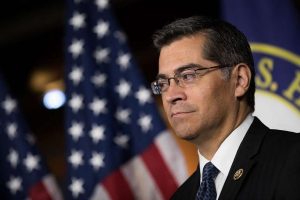Optimism in the Face of Disaster
Xavier Becerra

California Attorney General: Xavier Becerra / Source: Getty Images
Don’t apply for benefits, ask for a job. US unemployment centres are now hiring. In a single month, a virus invisible to the naked eye has wiped out a decade’s worth of job creation. In April, more than 20 million American workers filed for unemployment benefits. Morgan Stanley Chief US Economist Ellen Zentner expects the jobless rate to show some inertia yet and hit 16.4 percent next month – a level not seen since 1933 when a quarter of American workers was idled.
Back then, it took the Great Depression a full four years to push the unemployment rate to 25 percent – a seven-fold increase over the 3.2 percent registered in 1929 at the start of the long and steep downward slide. Economists and statisticians broadly agree that contemporary history offers no parallel to the speed with which the pandemic destroyed jobs.
For now, the only remaining hope is that once the virus has worked its way through society, the economy may be shifted into overdrive to make up for lost time and get people back into work. However, even the most sanguine of market watchers do not expect the unemployment rate to return to its pre-corona level for many years.
The non-farm payroll numbers published today by the US Bureau of Labor Statistics (BLS) do not include job losses outside the formal sector. According to Paul Ashworth of Capital Economics, an extrapolation of the latest data coming out of the Labour Department points to an overall US unemployment rate of 23 percent.
In its April report, the BLS recorded 20.5 million new applications for unemployment benefits, pushing the official jobless rate for the month to 14.7 percent. In February, only 3.5 percent of US workers were without a job – a 50-year low for which President Donald Trump took credit. The dismal news was taken in stride by Wall Street where Friday morning futures pointed to a strong opening of trade. Investors took heart from the soothing noises made by US and Chinese trade officials. European markets opened on a high as well.
Regarding the BLS report, Mr Ashworth remains cautiously optimistic and expects a significant part of the newly unemployed to be back at work within weeks after the end of lockdown. Economists at the Federal Reserve agree. In an analysis published late last month, they conclude that most layoffs are directly attributable to the temporary suspension of business activity. The study’s authors expect the unemployment rate to settle around the 7 percent mark by the end of the year.
US market analysts turn out to be an exceptionally upbeat lot. At Citigroup, chief economist Veronica Clark is convinced that the worst has already past and that most of the current claims for unemployment benefits are filed by people unable to do so in previous weeks when systems processing the paperwork were overloaded and unable to cope with the surge in demand.
According to a study by the University of California Santa Cruz, millions of Americans precariously employed in the gig economy, and often classified as ‘independent contractors’, fall through the cracks in the system and are amongst those most affected by the pandemic. Whilst app-based companies continue to pour money into a ballot initiative that would exempt them from employer regulations, gig workers such as delivery drivers go without sanitisers, gloves, masks, and information. Companies fear that supplying these essentials could possibly undermine the legal standing of their ‘associates’ and be construed as evidence of the existence of a more traditional, and much more expensive, employment relationship.
“Food and grocery delivery has been deemed essential work, and these workers are putting themselves at risk, but they are not getting adequate support or protection,” says Professor Chris Brenner who co-authored the study. The university’s survey of ride-hailing and food-delivery workers found that 21 percent of those queried had no form of health insurance and 13 percent depended on food stamps in order to get by. Almost half of the workers queried were unable to meet a $400 emergency expense without borrowing money.
Though the average weekly (pre-corona) takings reported by ride-hailing workers hover around $900, once adjusted for expenses using the same criteria as those employed by the Internal Revenue Service (IRS), one in five drivers often see their net earnings reduced to zero. “Fully 20 percent of these people actually pay to work,” says Prof Brenner. The results of the study are all the more remarkable because San Francisco boasts some of the toughest fair-labour standards in the US.
On Tuesday, California Attorney General Xavier Becerra said that he will sue app-based ride-hailing companies under a new law for misclassifying their drivers as contractors in an attempt to deny workers their rights and the state its taxes.
In the UK, gig economy workers are also left without much recourse. The country’s estimated five million self-employed are not covered by the government’s pledge to subsidise up to 80 percent of the wages of furloughed employees. Gig workers have only been offered limited tax relief and may draw the equivalent of $112 (£94) in benefits, an amount that comes nowhere close to covering basic living expenses. The Trades Union Congress, which represent over 50 British labour unions, has called on the government to extend its financial assistance programmes to include self-employed workers.
In a filing with the Securities and Exchange Commission, Uber announced its intention to fire 3,700 workers – about 14 percent of the company’s global workforce. Uber engages close to 14 million drivers worldwide who it qualifies as contractors even though they must comply with a vast set of regulations stipulated and enforced by the company. Uber’s closest competitor Lyft this week also announced a new round of firings whilst Airbnb already sent a quarter of its workforce home. WeWork, an app-based real estate company that offers start-ups shared office space, no longer has work for 250 employees and intends to fire more people later this month.
With their business model dependent on shared spaces – inside taxis, homes, hotels, and porticoes – gig companies may suffer a delayed rebound of their fortunes as app-users remain reluctant to occupy rooms or vehicles that may not have been properly disinfected. Both Uber and Airbnb this week updated their cleaning policies and standards with the latter offering guest the possibility to book a room, house, or apartment that has not been rented out in the three to seven days prior to their arrival.
Writing in The New York Times, Professor Paul Krugman of the City University of New York meanwhile wonders why conservatives in US Congress remain adamantly opposed to strengthening the social security safety net. Senator Lindsey Graham, a Republican from South Carolina, got visibly upset when asked about the structural enhancement of unemployment benefits: “Over my dead body.”
Senator Graham still advocates the reversal of the Affordable Care Act, better known as ‘Obamacare’, which he and fellow Republicans, including President Donald Trump, consider an expression of socialism. Republicans are also still trying to dial back the food stamp programme which helps impoverished families put food on the table. A recent study by the Brookings Institution found that food insecurity now affects one in five US households. Almost half of single-parent families with children under the age of twelve report food shortages.
Prof Krugman, recipient of the 2008 Nobel Memorial Prize in Economic Sciences, suspects that once introduced to the benefits of a more comprehensive social security net, American voters may decide to institutionalise such a welfare system. The popularity of the unapologetically socialist Vermont senator Bernie Sanders amongst the under-30 demographic may indicate a shifting in public opinion away from conservatism. In order not to split the Democratic ticket, Senator Sanders withdrew his candidacy for the party’s presidential nomination on April 8.
With the US unemployment rate nearing an all-time high, the pressure is on to end the lockdown and get the economy moving, even if the corona virus has not yet been completely contained. Concerned about his own electoral prospects, President Trump tries to strong-arm governors to open their states for business, disregarding the advice of virologists and immunologists. Although a dangerous tack to take, some exposure to risk may be called for given the unprecedented economic ravage caused by the corona pandemic.
You may have an interest in also reading…
Smoke and Mirrors Line the Fringes of the Pandemic
Luigi di Maio owes his rapid ascendancy in Italian politics to an almost virulent display of Euroscepticism. It propelled the
Invasion of the Robots! Beware, Beware! Just Because We Can Doesn’t Mean That We Should…
AI, facial-recognition, machine learning… where should humans draw the line when it comes to automated ‘job theft’? Yogesh Patel gives
World Bank on COVID-19: The Road Back Must Be Green, Resilient, and Inclusive
By Axel van Trotsenburg World Bank Managing Director of Operations COVID-19 has imposed a deeper, more widespread shock than the



















































































